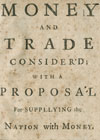Economic crisis 1637-2009
Introduction
 - Imaginary money, fictitious valuables, stock jobbing
- Imaginary money, fictitious valuables, stock jobbing
- Bankers and speculators are considered immoral
- 'Ordinary' people and tax payers eventually pay for the crisis
These three main ideas are common to the four-century-long history of economic crises. The researcher who wants to investigate this history will certainly end up working with materials in the IISH. The integrated collections of IISH and NEHA (Netherlands Economic History Archive) include:
- Manuscripts: not only Marx's Das Kapital, but also papers from the swindler Gregor MacGregor
- Unique contemporary sources, including a catalogue of tulips, booming business in 1637, and 18th-century sketches about speculators and bankers
- Image materials: posters, cartoons, and press photo collections illustrating the 20th century crises
- All classic writings from all great economists, mostly first editions
- Serial publications in support of research, including price lists since the Middle Ages
- All relevant titles on economic history in the IISH library, including 16,000 titles from the collection of the Economische Voorlichtingsdienst (library of the Dutch Government Department of Economic Affairs)
- Digital resources, including the website "Historical Prices and Wages" and "Value of the guilder" since 1450
Seven worldwide economic crises provide clear illustrations:
1637: Tulipmania
1720: Speculators
1763: Bankrupt
1822-1837: Adventurers
1929-1933: Great Depression
1973: Oil Crisis
2007-2009: Financial Crisis
Classics in the IISH Library
